Extra-long
Exposures
Although shutter speed settings are only provided to 1 second on the camera's shutter-speed
dial, longer speeds to 10 seconds are available via operation of the camera's self-timer
in conjunction with the "B" setting on the shutter-speed dial. Always use
a cable release to operate slow time exposure, unless intentional blur is dedired
for specific effect.
 |
The Nikon F2 also offers time exposure shooting convenience via built-in controls which enable long exposures without the need for accessory equipment. To make an exposure longer than 10 seconds, set the shutter-speed selector to "B" and turn the T- L finger guard to "T". |
Advance the film and press the shutter-release button to open the shutter. As long as the finger guard remains set to "T" and the shutter speed ring set to "B", the shutter will remain open. When returning the finger guard to the normal center position to close the shutter, be careful not to move or shake the camera, as a blurred image may result.
Shutter Release Operation
For sharp pictures, correct shutter releasing is just as important as steady camera holding. After advancing the film to a fresh frame, the camera is set for shutter release via the button provided at the upper right, When taking the picture, hold the camera steady (as explained previously), relax and depress the button using a steady even pressure to release the camera's shutter remember, a quick jab of the finger will cause camera movement and may result in a blurred photograph.
Holding the camera in a correct way
Camera shake is one of the most common causes of unsharp pictures, especially at slow shutter speeds. Learn to hold the camera correctly and practice steady shutter squeezing. The photos show the best ways to hold the camera for sharp pictures.
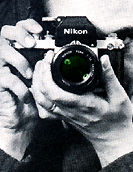 |
Wrap the fingers of the right hand around the camera body so that the index finger rests comfortably on the shutter-release button and the thumb fits between the camera body and the film-advance lever. Position the camera so that the eye looks through the center of the viewfinder. Cradle the camera in the left hand for additional support, with the left thumb and index finger grasping the focusing ring. |
As a general rule, the slowest shutter speed you should use with the camera handheld is equal to the reciprocal of the focal length of the lens in use (e.g., for a 500mm lens, use 1/500 sec.; for a 105mm lens, use 1/125 sec.), However, as the ability to hold the camera steady may vary with each individual, we recommend that you experiment. In general, the higher the selected shutter speed, the sharper the picture.
Operation via Cable Release
The shutter-release button can also be operated via a cable release or similar accessory attached via the threaded mount provided. With the cable release, operation is more vibration-free and often leads to sharper images under critical shooting situations such as photomicrography, time exposure, etc.
 |
To attach the cable release (Nikon-mount models AR-2, etc.) to the camera, screw the threaded cable connector onto the mount provided around the button. The shutter is then tripped by depressing the release plunger. |
Focusing
Focusing is done at full aperture with any Nikkor lenses fitted with an automatic diaphragm. This technique provides the brightest possible images on the focusing screen for easy focusing and composing. It also minimizes depth of field so that the image snaps in and out of focus distinctly. The Nikon Type K screen comes with the camera as standard equipment. To focus, turn the focusing ring on the lens until the two halves of the rangefinder image coincide to form a single, crisp image.
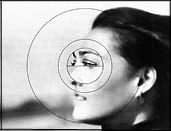 |
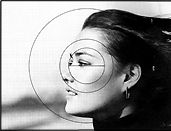 |
When using the microprism ring, turn until the microprism pattern shifts to a sharp and crisp image. You can also focus on the matte field that surrounds the rangefinder/microprism central area. |
Note: The lens can also be prefocused using the distance scale engraved in both meters and feet on the lens barrel. Simply turn the focusing ring until the desired camera-to-subject distance (as measured or estimated) is lined up with the distance scale index on the lens barrel. This technique is useful for candid shots of elusive subjects when time does not permit through-the-lens focusing.
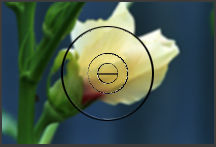 |
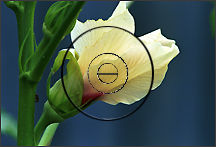 |
The shutter-release button is threaded to accept the Nikon Cable Release. For hand-held exposures at speeds slower than 1/30 second, greater sharpness can be obtained if the shutter release is tripped by means of the self-timer. |
Infrared
Photography
The plane of sharpest focus for infrared light is slightly more distant than its
counterpart for visible light as seen through the camera's viewfinder. Thus, for
sharpest focus in infrared photography, adjustments must be made.
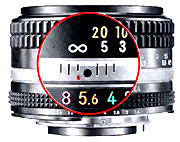 |
To compensate for this shift in focus, first focus the image sharply through the viewfinder. Then, turn the focusing ring counterclockwise until the point focused is aligned with the red dot (or line) provided on the lens barrel. For example, in the picture below, the lens has been focused for infinity (oo) for infrared shooting. Note that when lenses having a focal length of 50mm or less are used stopped down to f/8 or below, no adjustment is necessary due to the large depth of field available. |
Note: Some new series of Nikkor optics using Nikon's Extra-low Dispersion (ED) glass, as well as reflex (catadioptric) lenses, do not require refocusing for infrared photography.
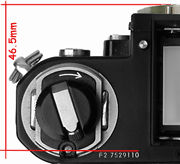 |
Under some precision shooting situations, such as close-up photography, it is often necessary to measure the film-to-subject distance to ensure the sharpest focus. The camera's film plane is indicated by the top edge of the figures making up the serial number at the upper left of the camera body. Note that these figures are 46.5mm from the front surface of the camera's lens mounting flange. |
| Previous | NEXT | 6 / 12 Depth of Field, Mirror Lock Up Lever, DOF Indicator on the lens, Exposure Control & Unusual Contrast Scenes
| Back | Index Page - Nikon F2
| Message Board | for
your favourite Nikon
F2 Series SLR model(s)
| Message Board | for your Nikon Optics in a shared environment
| Message Board | Specifically for Dispose or Looking for Nikon/Nikkor Photographic
Equipment
| Back |
to Main
Index Page of Nikon
F2 Series SLR models
| Back | Main Index Page of
Pictorial History of Nikon SLRs
 |
The Eyes of Nikon:- |
Fisheye-Nikkor Lenses - Circular | Full Frame | Ultrawides Lenses - 13mm15mm18mm20mm | Wideangle Lenses - 24mm28mm35mm |
Standard Lenses - 45mm 50mm 58mm | Telephoto Lenses - 85mm105mm135mm180mm & 200mm |
Super-Telephoto Lenses - 300mm 400mm 500mm 600mm 800mm 1200mm |
Special Application lenses:
Micro-Nikkor Lenses - 50mm~55mm -60mm 85mm -105mm 200mm Micro-Zoom 70-180mm
Perspective Control (PC) - 28mm 35mm PC-Micro 85mm
Dedicated Lenses for Nikon F3AF: AF 80mm f/2.8 | AF 200mm f/3.5 EDIF
Depth of Field Control (DC): 105mm 135mm
Medical Nikkor: 120mm 200mm
Reflex-Nikkor Lenses - 500mm 1000mm 2000mm
Others: Noct Nikkor | OP-Nikkor | UV Nikkor 55mm 105mm | Focusing Units | Bellows-Nikkor 105mm 135mm
Nikon Series E Lenses: 28mm35mm50mm100mm135mm | E-Series Zoom lenses: 36~72mm75~150mm70~210mm
MF Zoom-Nikkor Lenses: 25~50mm | 28~45mm | 28~50mm | 28~85mm | 35~70mm | 36~72mm E | 35~85mm | 35~105mm | 35~135mm |
35~200mm | 43~86mm | 50~135mm | 50~300mm | 70~210mm E | 75~150mm E | 80~200mm | 85~250mm |
100~300mm | 180~600mm | 200~400mm | 200~600mm | 360~1200mm | 1200~1700mm
Tele-Converters: TC-1 | TC-2 | TC-200 | TC-201 | TC-300 | TC-301 | TC-14 | TC-14A | TC-14B | TC-14C | TC-14E | TC-16 | TC-16A | TC-20E
![]()
Nikon F
| Nikon F2 |
Nikon
F3
| Nikon F4 |
Nikon
F5
| Nikon F6 |
Nikkormat / Nikomat |
Nikon FM
| Nikon FE/ FA | Nikon EM/FG/FG20 | Nikon Digital SLRs | Nikon - Other models
MIR Supports for Photographic Community: Various Message Boards/Community
Forums
Nikon
F-series|
Nikon
F2-series|
Nikon
F3-series|
Nikon F4-series| Nikon
F5-series|Nikkormat/Nikomat-series
Nikon FM-series|Nikon
FE-series|Nikon
FA|Nikon
Digital
SLR
series|Various
Nikon
Models|Nikkor
Optic
-shared
Others:- Free Trade Zone - Photography| Free Trade Zone - Business Community |Free To Zouk - Photographic Community
Apple's Mac Public Community Message Board | Windows based PC &
Apple/Mac
Public Community Trade Exchange Centre
Recommended links to understand
more technical details related to the Nikkor F-mount and production Serial Number:
http://rick_oleson.tripod.com/index-153.html by: my friend, Rick Oleson
http://www.zi.ku.dk/personal/lhhansen/photo/fmount.htm by: Hansen, Lars Holst
http://www.mir.com.my/rb/photography/hardwares/nikonfmount/lens2.htm
http://www.photosynthesis.co.nz/nikon/serialno.html
About this photographic site.
HOME - Photography in Malaysia |
Copyright © 2000. leofoo ®. MIR Web Development Team.
In
memory of my friend Com.
Augusto Staut,
Brazil, 1971-2000.
Credit: Chuck Hester, US for his patience, encouragement
and help to setup the various content in this site; Robert Johnson for some of his original
images on the F2H-MD appeared in this site; my ex-staff, KiaSu for his superb
3-D logo appeared in this Nikon F2 site; Marc Vorgers from Holland who
generously provide me with some of his images of F2AS; MCLau®, who has so much time with me to
re-edit the content in this site and not to mention buying a Nikon Coolpix 990 just
for this site. Keat Photo,
Kuala Lumpur for providing
their Nikon F2A to take some images for this site; again, Mr Edward Ngoh the
great camera collector who provides us his collection of F2AS with MD-2; hawkeye.photographic.com
for their images on the Speed Magny film backs; Sean Cranor for his image
on Nikon F2 25th Anniversary Model; Ted Wengelaar®, Holland for his continuous
flow of input on some of the early Nikon bodies; CYLeow ® , photo editor of the Star
newspaper, Malaysia for some of his images used in this site. Ms Rissa Chan, Sales manager from
Shriro Malaysia who has helped to provide some of the very useful input. HiuraShinsaku®,
Nikomat ML, Japan for some of his images on various F2 models; my staff, Wati, Maisa, Mai and my nephew, EEWyn®, who volunteered and helping me
did so many of the film scanning works. Contributing photographers or resellers:
Jen Siow, Foo KokKin, Arthur Teng, Mark Fallander, John
Ishii, Ed Hassel, YoonKi Kim, Jean-Louis, M.Dugentas (Dell Corner.com.), Mr "Arsenall" and a few images mailed
in from surfers with no appropriate reference to their origin. Dedicated to KU Yeo, just to express our mutual regrets over the outcome of
a recent corporate event. Made with a PowerMac, broadcast with a Redhat Linux powered server.
![]()
![]()